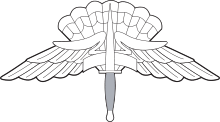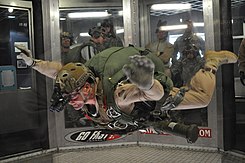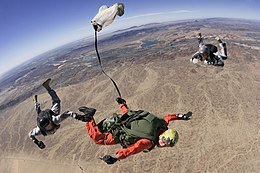| Military Freefall Parachutist Badge | |
|---|---|
 Military Freefall Parachutist Badge Military Freefall Parachutist Badge | |
| Type | Badge |
| Awarded for | Qualification as a high-altitude parachutist |
| Presented by | U.S. Army and U.S. Air Force |
| Status | Currently awarded |
| First awarded | 1 October 1994 |
| Last awarded | On going |
 Master Military Freefall Parachutist Badge Master Military Freefall Parachutist Badge | |
| Army Precedence | |
| Next (higher) | Parachute Rigger Badge |
| Next (lower) | Army Aviator Badges |
The Military Freefall Parachutist Badge is a military badge of the United States Army and United States Air Force awarded to qualified U.S. Army and U.S. Air Force personnel as high-altitude military parachute specialists.
Qualifications
To earn the Military Freefall Parachutist Badge, the military member first must receive all necessary ground training, already have earned the Military Parachutist Badge (jump-qualified), and must have completed the requisite freefall (night, combat equipment, oxygen) jumps and graduate from the Military Free-Fall Parachutist Course.
A star and laurel wreath, centered above the badge, called the Master Military Freefall Parachutist Badge, is authorized for U.S. Army Soldiers and U.S. Air Force Airmen qualified as a Master Military Freefall Parachutist (Jumpmaster). Such qualification requires completing the Military Free-Fall Jumpmaster Course, wherein the student learns how to be a jumpmaster in military freefall operations.
As with the U.S. Army's Military Parachutist Badge, small bronze and gold stars are placed on the badge to represent participation in combat jumps, known as Combat Jump Devices, and can be awarded with either the basic and master versions of the badge. To earn the device, a Military Freefall Parachutist must have conducted a High-altitude/low-opening (HALO) or high-altitude/high-opening (HAHO) jump in a war zone. The stars are awarded as follows:

| One combat jump | A bronze star centered on the dagger |
| Two combat jumps | A bronze star on each wing |
| Three combat jumps | A bronze star on each wing and one centered on the dagger |
| Four combat jumps | Two bronze stars on each wing |
| Five + combat jumps | A large gold star centered on the dagger |
| Date | Unit | Operation | Troopers | Country | Dropzone |
|---|---|---|---|---|---|
| 28 November 1970 | Recon Team Florida, CCN, MACV-SOG (HALO) | Vietnam Conflict | 3 Americans, 1 ARVN officer and 2 Montagnards | Laos | NVA road inside Laos |
| 7 May 1971 | Captain Larry Manes' Recon Team, CCN, MACV-SOG (HALO) | Vietnam Conflict | 4 | South Vietnam | Between Ashau Valley and Khe Sanh, NVA trail extension of Laotian Highway 921 |
| 22 June 1971 | Sergeant Major Billy Waugh's Recon Team, CCN, MACV-SOG (HALO) | Vietnam Conflict | 4 | South Vietnam | 60 miles SW of Danang |
| 22 Sep. 1971 | Captain Jim Storter's Recon Team, CCC, MACV-SOG (HALO) | Vietnam Conflict | 4 | South Vietnam | Plei Trap Valley, NW of Pleiku |
| 11 October 1971 | Sergeant First Class Dick Gross' Recon Team, CCC, MACV-SOG (HALO) | Vietnam Conflict | 5 | South Vietnam | 25 miles, SW of Pleiku in the Ia Drang Valley |
| 15 January 1991 | 1st Special Forces Operational Detachment-Delta (HAHO) | Operation Desert Shield | 12 | Iraq | Northwest desert |
| 3 July 2004 | 75th Ranger Regiment, Regimental Reconnaissance Detachment, Team 3 (HALO) | Operation Enduring Freedom | Afghanistan | Southeastern region | |
| 30 May 2007 | 10th Special Forces Group, 3rd Battalion, ODA 074 (HALO) | Operation Iraqi Freedom | 11 | Iraq | Ninewah Province |
| 11 July 2009 | 75th Ranger Regiment, Regimental Reconnaissance Company, Team 1 | Operation Enduring Freedom | Afghanistan |
History of the badge's design
The original design of the Military Freefall Parachutists Badge was submitted in March 1983 by Sergeant First Class Gregory A. Dailey of Special Forces ODA-552, Company B, 2nd Battalion, 5th Special Forces Group. Updates on the design, adding a Master Military Freefall Parachutist Badge, were submitted by General Wayne A. Downing of U.S. Special Operations Command (USSOCOM) and James Phillips of the Special Forces Association. The badges were approved for wear by U.S. Army soldiers assigned to U.S. Army Special Operations Command (USASOC) on 1 October 1994. Unrestricted wear was approved on 7 July 1997 by General Dennis Reimer.
Symbolism of the badge's design:
- The dagger is a Fairbairn–Sykes fighting knife, used by the Office of Strategic Services during World War II, and represents infiltration techniques.
- The arched tab represents tabs worn by special operations forces.
- The parachute is a seven-celled MT1-X, the first ram-air parachute to be adopted by the U.S. Military as the standard freefall canopy.
- The wings represent flight and airborne capabilities.
Free-fall training
 Historical Example of Free-Fall Training
U.S. Army Special Forces learning early free-fall HALO techniques, c. 1966
Historical Example of Free-Fall Training
U.S. Army Special Forces learning early free-fall HALO techniques, c. 1966
The U.S. Military Free-Fall School (MFFS) is operated by the USASOC's John F. Kennedy Special Warfare Center and School (SWCS), 2nd Special Warfare Training Group (Airborne), 2nd Battalion, Company B at the U.S. Army's Yuma Proving Ground (YPG) in Arizona, which is the USSOCOM proponent for military freefall. The MFFS conducts four primary training courses, the Military Free-Fall Parachutist Course, the Military Free-Fall Jumpmaster Course, the Military Free-Fall Advanced Tactical Infiltration Course, and the Military Free-Fall Instructor Course. The U.S. Air Force also conducts the Military Free-Fall Jumpmaster Course—certified by the MFFS—at Davis–Monthan Air Force Base in Arizona for airman that are not able to attend the MFFS's jumpmaster course. Alternatively, detachments from the MFFS conduct the Military Free-Fall Jumpmaster Course via mobile training teams (MTT) for military free-fall units that have difficulty attending the course at the Yuma Proving Ground.
 A Parachute Rigger from SWCS demonstrates the proper packing procedure for the RA-1 main parachute
A Parachute Rigger from SWCS demonstrates the proper packing procedure for the RA-1 main parachute An instructor and a MFFS student fall from a C-27J practicing free-fall techniques over YPG
An instructor and a MFFS student fall from a C-27J practicing free-fall techniques over YPG
The Military Free-Fall Parachutist Course (MFFPC) is open to special operations forces assigned to military free-fall coded positions, parachute riggers, and select DoD civilian personnel or allied personnel assigned to military free-fall positions. To attend MFFPC, students must have graduated from the U.S. Army Airborne School and must meet specific medical requirements. Week one of the four-week course focuses on vertical wind tunnel body stabilization training at the MSG George A Bannar Wind Tunnel as well as parachute packing and an introduction to military free-fall operations. The remaining weeks focuses training on varying jump profiles using three airborne operations per training iteration, totaling 30 military free-fall operations per course encompassing various conditions and equipment loads. At the end of the course, students will have learned how to:
- Pack the RA-1 Military Free-Fall Advanced Ram-Air Parachute System main parachute and don the system
- Rigging/jumping procedures for weapons, combat equipment, night vision goggles and portable oxygen equipment
- Aircraft procedures
- Exit an aircraft from the door and ramp using dive and poised exit positions
- Emergency procedures and body stabilization
- HALO and HAHO parachute jumps from altitudes of 10,000 ft (3,048 m) to 25,000 ft (7,620 m)
Upon completion of the MFFPC, graduates are awarded the Military Freefall Parachutist Badge.
 A MFFJMC student conducts HAHO operations planning at YPG
A MFFJMC student conducts HAHO operations planning at YPG U.S. Air Force MFFJMC students practice conducting the jumpmaster personnel inspection on each other at Davis–Monthan Air Force Base
U.S. Air Force MFFJMC students practice conducting the jumpmaster personnel inspection on each other at Davis–Monthan Air Force Base A U.S. Marine MFFJMC student gives jump commands during the MTT's first overseas course at Kadena Air Base, Japan (2017)
A U.S. Marine MFFJMC student gives jump commands during the MTT's first overseas course at Kadena Air Base, Japan (2017)
To attend the Military Free-Fall JumpMaster Course (MFFJMC), students must have graduated from the U.S. Army Airborne School, the MFFPC, the U.S. Army Jumpmaster School, be a current military free-fall parachutist, served as a military free-fall parachutist for a minimum of one year, and must have completed at least 50 military free-fall jumps. The three-week MFFJMC focuses on training students on jumpmaster duties and responsibilities, such as:
- Nomenclature
- Jumpmaster personnel inspection
- Emergency procedures
- Oxygen equipment
- Wind drift calculations
- Altimeter calculations
- Emergency automatic activation device calculations
- Jump commands
- Aircraft procedures
- Techniques of spotting
- HAHO techniques
- Various ram-air parachute systems packing and rigging
Upon completion of the MFFJMC, graduates are awarded the Master Military Freefall Parachutist Badge.
 A MFFATIC student practices freefall techniques with various equipment in the MSG George A Bannar Wind Tunnel, YPG
A MFFATIC student practices freefall techniques with various equipment in the MSG George A Bannar Wind Tunnel, YPG MFFATIC instructors and students conduct a HAHO water insertion operation from a C-23 off the coast of Key West, Florida
MFFATIC instructors and students conduct a HAHO water insertion operation from a C-23 off the coast of Key West, Florida
To attend the Military Free-Fall Advanced Tactical Infiltration Course (MFFATIC), students must have the same qualifications and completed the same prerequisites required of the MFFJMC. The three-week MFFATIC focuses on educating and training joint special operations forces and other selected personnel in the planning and conduct of night military free-fall tactical infiltrations as a group onto unknown and unmarked drop zones. Training includes:
- Following GPS guided bundles
- Carrying various combat equipment
- Various communications
- Wearing various night vision devices
- Jumping with non-standard weapons while using oxygen equipment
- Utilization of various parachutist navigational devices
Upon completion of the MFFATIC, graduates are awarded a certificate of completion; there is no badge or badge device awarded for completion of the MFFATIC.

To attend the Military Free-Fall Instructor Course (MFFIC), students must be a commissioned officer, warrant officer, or non-commissioned officer and must have the same qualifications and completed the same prerequisites required of the MFFJMC and MFFATIC. Additionally, these students must be qualified military free-fall jumpmasters, must have completed a minimum of 100 free-fall parachute jumps, and must have nine months remaining in service upon graduation. The initial nine-week MFFIC focuses on the following over 150-200 free-fall jumps:
- Learn how to conduct military free-fall jumps from the instructor's perspective
- Jump as an instructor evaluating and coaching a current MFF instructor who plays the role of a new MFF student
- Learn how to deal with multiple instructor-induced problems during free-fall commonly encountered with new MFF students
After nine weeks of fundamentals, student-instructors are placed as shadows at the MFFPC for three to six months.
Upon completion of the shadow program, graduates are awarded the Military Free-Fall Instructor Rating; there is no badge or badge device awarded for completion of the MFFIC.
See also
- Parachutist Badge (United States)
- Parachutist Badge
- Parachute Rigger Badge
- Pathfinder Badge
- Badges of the United States Army
- Badges of the United States Air Force
- United States Military Parachute Rigger School
- United States Army Air Assault School
- United States Army Pathfinder School
- No. 1 Parachute Training School RAF
- Parachute Training School (Australian Army)
- Parachute Training School (Pakistan Army)
- United States Army Parachute Team
- United States Army Maneuver Center of Excellence Command Exhibition Parachute Team
- United States Special Operations Command Parachute Team
- "Blood on the Risers"
- United States Army Reconnaissance and Surveillance Leaders Course
References
- ^ Research Center, Military Free Fall Parachute Badge, U.S. Army Quartermaster Museum, last updated 28 December 2015, last accessed 8 October 2022
- ^ Army Regulation 600-8-22 Military Awards, Table 8-2, U.S. Army Badges and Tabs: Orders of precedence. p. 130, U.S. Department of the Army, dated 5 March 2019, last accessed 8 October 2022
- Air Force Guidance Memorandum to Air Force Manual (AFMAN) 11-402, Aviation and Parachutist Service, U.S. Department of the Air Force, dated 13 September 2022, last accessed 8 October 2022
- ^ MFFPC ATRRS Information Changes, U.S. Army Special Operations Center of Excellence, last accessed 3 January 2020
- ^ Military Free-Fall Jumpmaster Course (MFFJMC), U.S. Army Special Operations Center of Excellence, last accessed 3 January 2020
- Qualification Badges, Military Free Fall Parachutist Badge, United States Army Institute of Heraldry, last accessed 22 April 2017
- United States Combat Jumps, GlobalSecurity.org, last updated 7 May 2011, last accessed 6 January 2019
- Units Credited With Assault Landings, General Orders No. 10, Department of the Army, dated 25 September 2006, last accessed 6 January 2019
- Hitting the ground with coalition partners; Special Warfare Magazine; Valume 21, Issue 6; dated November–December 2008, last accessed 6 January 2019
- History of Military Operational Parachute Jumps, Special Forces Association, dated 7 March 2013, last accessed 6 January 2019
- These are the only 5 combat jumps by US troops that we know about since September 11, Business Insider, by Eric Milzarski from "We Are The Mighty" program, dated 7 October 2019, last accessed 9 July 2020
- Welcome to the official website of the 2nd Special Warfare Training Group (Airborne), soc.mil, last accessed 14 April 2020
- Special Forces Qualification Course to incorporate military free-fall training, Army.mil, by MAJ James Branch (USA), dated 4 October 2012, last accessed 22 April 2017
- ^ 1st Special Warfare Training Group (Airborne), U.S. Army Special Operations Center of Excellence, last accessed 22 April 2017
- ^ Welcome to the official website of the Military Free-Fall Instructor Course (MFFIC), Yuma Proving Ground, AZ, www.soc.mil, last accessed 3 May 2020
- Mastering the jump, Davis-Monthan Air Force Base official page, by Airman Nathan H. Barbour, dated 1 July 2016, last accessed 22 April 2017
- First Ever Military Freefall Jumpmaster Course Hosted Overseas, Defense Video & Imagery Distribution System, by LCpl Jordan Talley, dated 21 April 2017, last accessed 3 January 2020
- RA-1 Military Freefall System Config Packing, U.S. Army John F. Kennedy Special Warfare Center and School, curtesy of "Deez Nutz" YouTube Channel, dated 17 November 2017, last accessed 21 September 2020
- How to Pack the RA-1 Main in Free Fall Configuration using PRO Pack Procedures, U.S. Army (curtesy of "Sky Shark" YouTube Channel), dated 10 August 2019, last accessed 27 September 2020
- Military Free-Fall Advanced Tactical Infiltration Course (MFFATIC), U.S. Army Special Operations Center of Excellence, last accessed 3 January 2020
- ^ Inside the Special Forces Military Free Fall School, Coffee or Die YouTube Channel, by Marty Skovlund Jr, dated 1 May 2020, last accessed 3 May 2020
| Badges of the United States Army | |
|---|---|
| Special Skill Group 1 | |
| Special Skill Group 2 | |
| Special Skill Group 3 | |
| Special Skill Group 4 | |
| Special Skill Group 5 | |
| Special Skill Group 6 | |
| Identification | |
| National Guard and Other | |